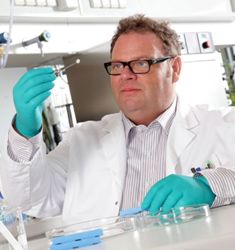Synthetic cornea solves problem of transplant rejection
24 May 2010
An artificial cornea made from specially adapted lens polymer is bringing sight to many patients who can't tolerate donor corneas.
Each year, 40,000 people in Europe who become blind after an accident or illness join the queue for a new cornea. For many patients, a corneal transplantation could restore the ability to see, however, some of these cannot tolerate donor corneas.
Dr Joachim Storsberg of the Fraunhofer Institute for Applied Polymer Research IAP in Potsdam-Golm developed the material and production process for a corneal prosthesis made of plastic. These can help patients who are unable to tolerate donor corneas due to the special circumstances of their disease, or whose donor corneas were likewise destroyed. In recognition of this accomplishment, Dr Storsberg is being awarded the 2010 Joseph von Fraunhofer Prize.
 |
| Dr Joachim Storsberg holding a synthetic corneal implant. (Photo credit: Fraunhofer/ Dirk Mahler) |
Encountering these problems would require the patient to get a new lens prosthesis after a relatively brief period of time. In addition, the outer side of the implant must be able to be moistened with tear fluid, so that the eyelid can slide across it without friction.
Dr Storsberg found the solution with a hydrophobic polymer material. This material has been in use for a long time in ophthalmology, such as for intraocular lenses. In order for it to satisfy the various characteristics required, complex development steps were necessary. The material was thoroughly modified on a polymer-chemical basis, and subsequently re-tested for public approval.
In order to achieve the desired characteristics, the edge of the implant was first coated with various, special polymers. Then, a special protein was added that contains the specific sequence of a growth factor. The surrounding natural cells detect this growth factor, are stimulated to propagate and populate the surface of the corneal margin. Thus, the cells of the surrounding tissue grow with the implant, and the artificial cornea attains stability.
The eye prosthesis was developed jointly with physicians and manufacturers over three years in the EU project Artificial Cornea. In a first step, they sent the chemical-biomimetic coated implant to Dr Karin Kobuch of the Poliklinik für Augenheilkunde at the Regensburg University Medical Center and to the medical center at the Technical University of Munich. The physician examined the artificial corneas in dissected pigs eyes and specialized cell cultures.
Eventually, the team under Dr Gernot Duncker and Dr Saadettin Sel of the University Center for Ophthalmology in Halle (Saale) tested the more complex models in rabbits. There, the design was further refined: the optics were made smaller, and the implant haptic enlarged in order to maintain a more stable construction. Miro GmbH manufactured the implant, robin GmbH handled the distribution and sales and supported the specially adapted implantation centres in Europe. By 2009, a prosthesis was already successfully in use; further implantations are anticipated during the first six months of 2010.